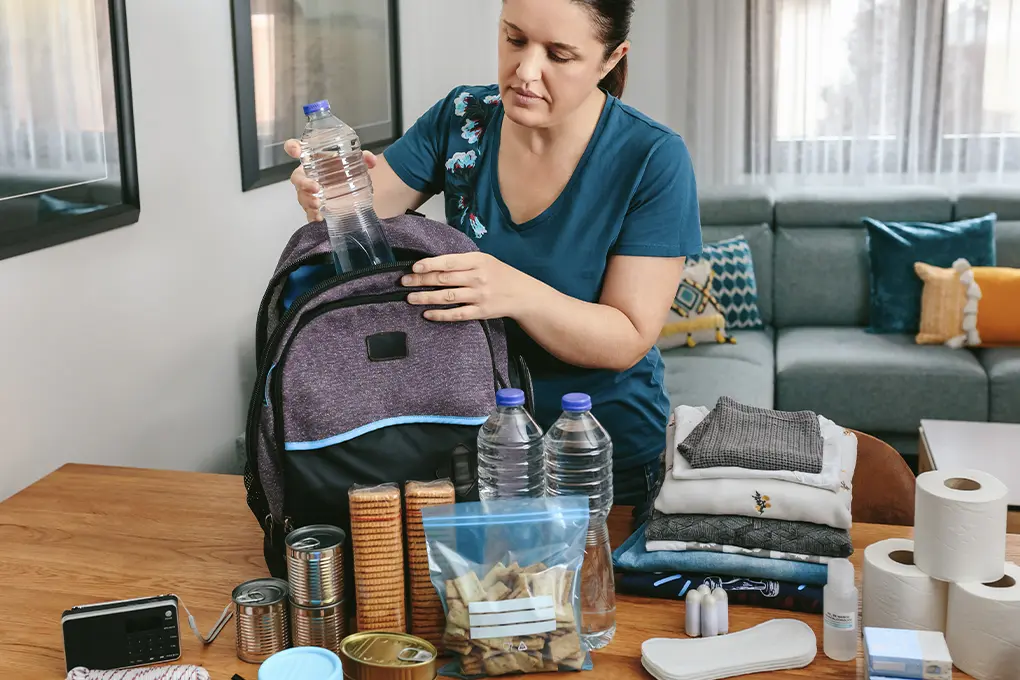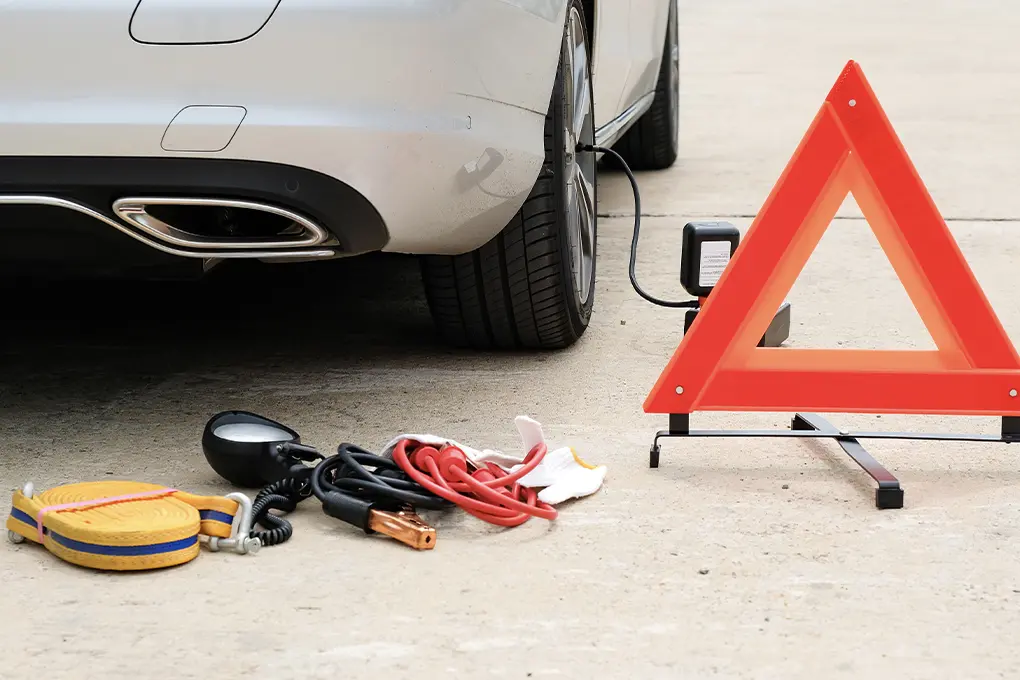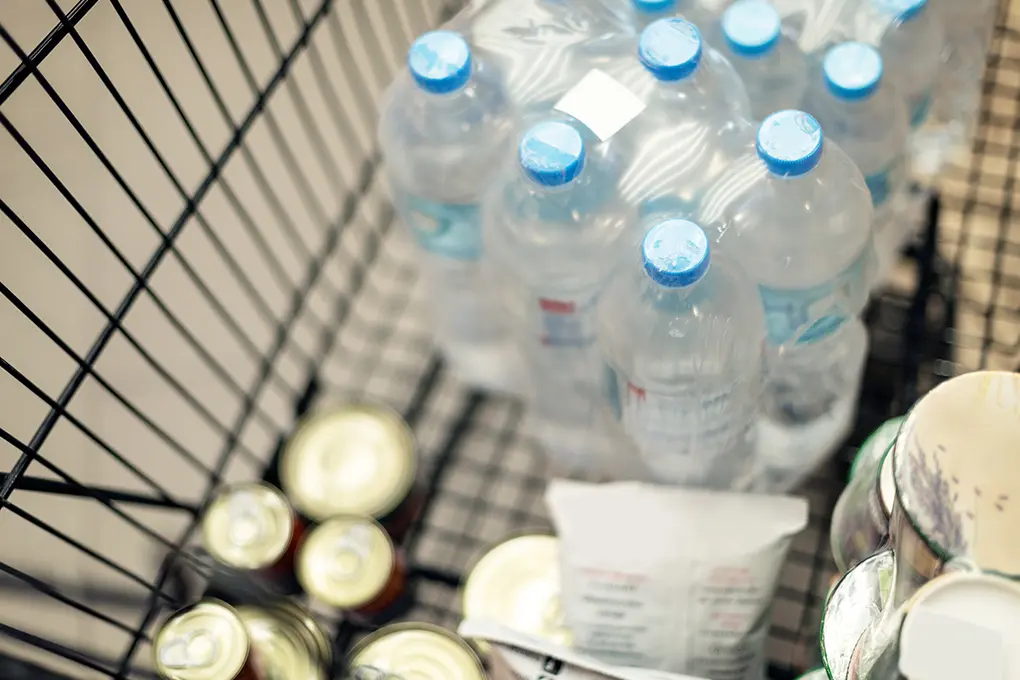When the ground begins to tremble beneath your feet, having a solid earthquake preparedness plan can mean the difference between panic and protection, and that’s important, seeing as the USA suffers an average of 16 major earthquakes per year.
Part of staying prepared is having a comprehensive home escape plan for emergencies, such as fires, floods, and earthquakes, so your family knows exactly how to react when disaster strikes.
Earthquakes strike without warning, giving you mere seconds to react, but with proper preparation, you can significantly improve your family’s chances of emerging safely from even serious seismic events.
This guide walks you through practical, proven strategies for before, during, and after an earthquake to keep you and your loved ones safe.
Contents
Key Takeaways
- Earthquake preparation starts with securing heavy furniture and appliances to prevent injuries during shaking.
- A complete emergency kit should support each household member for at least 72 hours, ideally a full week.
- A practiced family plan helps everyone know where to go, what to do, and how to communicate during and after a quake.
- Drop, cover, and hold on is the most reliable safety method during an earthquake regardless of location.
- Immediate post-quake steps include checking for injuries, inspecting for hazards, and using communication devices wisely.
- Aftershocks can be just as dangerous and require continued caution and readiness to act.
- Families with kids, people with disabilities, and pet owners must take special steps to ensure everyone’s needs are covered.
Before an Earthquake: Preparation & Mitigation
The most effective earthquake safety steps are taken long before any shaking begins. Preparing in advance reduces your risk of injury, limits property damage, and puts your family in a better position to recover quickly. Below are three essential areas to focus on: securing your home, assembling emergency supplies, and developing a family emergency plan.
Secure Your Home
Most injuries during earthquakes happen due to falling or shifting objects, not complete structural collapse. Therefore, securing your living space is one of the most important steps you can take.
Begin with a full assessment of your home. Identify tall or heavy items such as bookshelves, televisions, refrigerators, mirrors, and overhead fixtures. These can tip over, fall, or become projectiles during seismic shaking.
To secure your home effectively:
- Anchor tall furniture like bookcases, wardrobes, and display cabinets to wall studs using furniture straps, L-brackets, or anti-tip kits
- Secure appliances such as refrigerators, water heaters, and washers with heavy-duty straps and flexible gas and water connectors
- Install safety latches on kitchen and bathroom cabinets to prevent glassware, dishes, and toiletries from spilling out
- Place heavier or breakable objects on lower shelves
- Use museum putty or quake wax to secure small decorative items, vases, and electronics
- Hang mirrors, framed pictures, or artwork away from beds, couches, or anywhere people sleep or sit
- Use flexible pipe fittings to minimize the risk of gas or water line ruptures
- Repair any cracks in walls, ceilings, or the foundation to improve structural resilience
These small changes significantly reduce injury risks and can prevent costly damage during a quake.
Prepare Your Earthquake Emergency Kit
A well-stocked emergency kit is vital after a major earthquake, especially when utilities may be disrupted and emergency services overwhelmed. While the standard recommendation is to prepare for 72 hours of self-sufficiency, many preparedness professionals suggest planning for at least one week.
Your emergency kit should include:
- One gallon of water per person per day
- Shelf-stable, ready-to-eat food items
- Manual can opener
- First aid supplies, including prescription medications
- Flashlights and extra batteries
- Battery-powered or hand-crank emergency radio
- Dust masks and safety goggles
- Heavy-duty work gloves
- Whistle for signaling rescuers
- Multipurpose tools such as pliers and wrenches (to shut off gas or water valves)
- Local maps and a list of nearby emergency shelters
- Cash in small bills (ATMs and credit card systems may be offline)
- Portable phone chargers or power banks
- Photocopies of essential documents in a waterproof pouch
- Blankets, sleeping bags, and seasonal clothing
- Basic hygiene items such as toothbrushes, soap, and sanitary products
- Supplies for pets, including food, leashes, and carriers if needed
Store this kit in a sturdy, easy-to-carry container near the front door or another easily accessible location.
For extra preparedness, keep smaller versions in your car, workplace, and even next to your bed. A bedside kit should include a flashlight, whistle, closed-toe shoes, and gloves in case you need to move through debris in the dark.
If assembling your own kit feels overwhelming, companies like Batten Emergency offer professionally curated kits that include most of these items and can save you time and guesswork.
Create a Family Emergency Plan
In the confusion following an earthquake, a clear and practiced plan helps everyone know what to do, where to go, and how to stay in touch.
To build a reliable plan, start by discussing the following with your household:
- Identify safe zones in each room (such as under sturdy tables or against interior walls)
- Teach the Drop, Cover, and Hold On method and practice it regularly
- Assign roles in advance, such as who will shut off the gas, grab the emergency kit, or handle pets
- Decide how to communicate if cell towers are overwhelmed (texting often works better than calling)
- Choose two meeting locations: one near your home and another in your neighborhood, in case the house is unsafe
- Designate an out-of-area contact who can act as a communication relay
Consider creating a one-page family emergency reference sheet. Include responsibilities, contact numbers, medical info, and meeting points. Laminate it and store copies in your emergency kits, vehicles, and with each family member.
Regular practice makes these procedures second nature. Aim to run drills at least twice a year, including nighttime or weekend scenarios when family members may be scattered.
During an Earthquake: Staying Safe
When an earthquake begins, you have only seconds to react. Your safety depends on quick, informed action. The “Drop, Cover, and Hold On” technique remains the most effective way to protect yourself in nearly all situations. However, your surroundings will influence how and where you apply this method.
Drop, Cover, and Hold On
These three steps provide the foundation for earthquake safety:
- Drop to the ground before the shaking knocks you over
- Cover your head and neck with one arm and crawl under a sturdy table or desk if one is nearby
- Hold On to your shelter until the shaking stops
If no sturdy furniture is available, stay low to the ground and cover your head and neck with your arms. Remain in place until the shaking completely ends. Avoid moving around, as most injuries occur from falling objects or attempting to run during the quake.
Be aware that aftershocks are common. These smaller quakes can follow the main event and still cause injury or structural damage. Remain alert and ready to protect yourself again.
Adjusting Your Response Based on Location
Where you are during an earthquake affects the actions you should take. Below are recommendations for various scenarios.
If You Are Indoors
Staying inside is almost always safer than trying to exit during shaking. Buildings rarely collapse entirely, but doorways, windows, and heavy furniture pose serious risks.
- Move away from windows, glass doors, and anything that might fall, such as ceiling fixtures or unsecured shelves
- Do not stand in doorways. Despite the myth, modern doorframes do not offer more protection than other areas
- If you cannot reach a sturdy desk or table, crouch down next to an interior wall, cover your head and neck, and stay low
- Stay in bed if you are already lying down. Use a pillow to protect your head, and wait until the shaking stops
- Never attempt to run outside while the ground is moving. You are more likely to be injured by falling debris. During the Northridge Earthquake, for instance, over a quarter of the fatalities were caused by falling debris.
If You Are Outdoors
The primary goal is to avoid being struck by collapsing structures, broken glass, or falling trees.
- Move to an open space away from buildings, utility poles, power lines, streetlights, and trees
- If there is no clear open area nearby, crouch down next to a building and protect your head
- Stay put until the shaking stops completely. Avoid re-entering buildings until they have been inspected for structural damage
If You Are Driving
Earthquakes can severely affect road conditions and structures. Sudden movements or overpasses may collapse or shift during a strong quake.
- Safely pull over to the side of the road, away from overpasses, bridges, power lines, and tall buildings
- Remain inside your vehicle with your seatbelt fastened
- Keep your radio on for emergency broadcasts and updates
- Do not attempt to drive until the shaking stops and you’ve assessed for hazards like downed wires or road damage
If You Are in a High-Rise Building
High-rise buildings may sway more than shorter structures, but they are designed to absorb seismic motion. Your best protection is staying put and following basic safety protocols.
- Drop, cover, and hold on as instructed
- Stay away from windows, glass partitions, and unsecured objects
- Do not use elevators during or immediately after an earthquake
- Expect that fire alarms or sprinkler systems may activate
- Stay calm and wait for official instructions before evacuating
If You Become Trapped Under Debris
Staying calm and conserving energy are critical if you find yourself trapped.
- Cover your nose and mouth with a cloth or sleeve to avoid inhaling dust
- Avoid shouting unless absolutely necessary to preserve oxygen
- Tap on nearby pipes, walls, or other objects to signal your location
- Use a whistle if you have one on hand
- Do not light matches or create sparks, as gas leaks are possible
Practice Matters
During a recent earthquake in Seattle, I saw firsthand how preparation impacts outcomes. People who had practiced earthquake drills responded immediately, while others hesitated or panicked. This delay, even if brief, can result in injury. Regular practice helps build instinctive responses so that you act automatically when it matters most.
Practice drills at home, work, and school to reinforce muscle memory. Make sure everyone in your household knows the basic safety steps and what to do in each room. This simple habit can dramatically increase your chances of staying safe during a real quake.
After an Earthquake: Recovery and Safety
Once the shaking stops, your focus should shift to staying safe and beginning the recovery process. Your actions during the first few minutes, hours, and days are critical; not just for your household but for your wider community. Remaining calm and methodical will help prevent additional harm and make it easier to assess damage and secure needed support.
Immediate Steps to Take
In the moments following an earthquake, begin by checking for injuries and inspecting your environment for hazards.
Check for Injuries
- Examine yourself first for injuries before helping others
- Administer basic first aid for cuts, bruises, or minor wounds
- Do not move seriously injured people unless they are in immediate danger from fire, flooding, or falling debris
- If trained, assist with CPR or bleeding control as needed
Keep your first aid supplies accessible at all times. If your kit was disturbed during the quake, locate it and restock essentials if possible.
Inspect for Hazards and Damage
Next, check your surroundings for potential dangers that may require immediate action:
- Look for small fires and extinguish them if it is safe to do so
- Smell for gas leaks or listen for a hissing sound. If you suspect a leak, turn off the gas at the main valve and leave it off until cleared by a professional
- Inspect electrical wiring and outlets for visible damage. Turn off electricity at the main breaker if you see sparks, smoke, or frayed wires
- Avoid using candles or open flames due to the potential for gas leaks
- Examine walls, ceilings, and foundations for visible cracks or shifting
If your building shows serious structural damage, leave immediately and move to a safer location. Be aware that stairways may be compromised even if they appear intact.
Use Communication Tools Wisely
Communication systems often become overwhelmed or unreliable following an earthquake. Prioritize emergency messaging and conserve power when possible.
- Use text messages rather than phone calls, as texts use less bandwidth and are more likely to go through
- Contact your designated out-of-area contact to let them know you are safe
- Listen to a battery-powered or hand-crank radio for emergency broadcasts, shelter locations, and updates
- Limit non-essential phone use to preserve battery power and reduce strain on networks
Understanding Aftershocks
Aftershocks are smaller quakes that follow the main earthquake and can occur minutes, hours, or even weeks later. They can damage structures already weakened and pose serious risks if you’re not prepared.
- Expect aftershocks and stay ready to drop, cover, and hold on again
- Avoid re-entering buildings that appear damaged, even briefly
- Evacuate structures that continue to shift or make creaking sounds
- If you feel shaking, move away from windows and unstable furniture
Each aftershock is a reminder to stay alert. Return to damaged buildings only once they have been officially inspected.
Beginning the Recovery Process
Once the immediate danger has passed, begin organizing your next steps toward safety, cleanup, and restoration.
Document the Damage
- Photograph structural damage, broken items, and impacted areas for insurance claims
- Keep a list of damaged possessions and note any visible cracks, leaks, or utility issues
- Store digital copies of documents and photos if you have internet access, or use cloud storage if possible
Check on Others
- Check on neighbors, especially older adults, individuals with disabilities, or families with young children
- Offer help if you can, or assist them in contacting emergency services
- Coordinate small group efforts for cleanup and resource sharing when safe
In many past earthquakes, neighborhoods that maintained strong local networks recovered faster due to better communication and mutual aid. If your area does not have a formal emergency group, consider starting one during the recovery phase.
Clean Up Hazards
- Safely clean up broken glass, spilled chemicals, and sharp debris
- Use gloves and thick-soled shoes to avoid injury
- Avoid moving large or unstable furniture alone
- Be careful when opening cabinets or closets. Items may have shifted and could fall out
If you see spilled medications, household cleaners, or flammable liquids, handle them with extra care. Use absorbent materials and ventilate the area.
Follow Official Safety Guidance
Authorities may issue health and safety advisories in the hours and days after a major quake. Always follow local guidance, especially regarding utilities, road closures, and public health concerns.
- Do not drink tap water unless officials have declared it safe
- Boil water or use purification tablets if contamination is suspected
- Use only designated shelters and aid centers for food or medical assistance
- Wait for clearance before re-entering buildings marked for inspection
Monitor emergency broadcasts for updates. Public safety agencies will issue alerts through radio, official apps, and social media when available.
The Value of Community Connection
After the Northridge earthquake, I helped coordinate response efforts in my neighborhood. What stood out most was how vital it was to have established relationships in place before the disaster.
The areas that recovered more quickly were those where people already knew their neighbors, had shared contact lists, and were familiar with each other’s needs.
Building this kind of connection doesn’t require much. A simple group text, a shared emergency plan, or neighborhood contact sheet can make a significant difference. If you haven’t yet, consider organizing or joining a local emergency response network. The support you give and receive may be one of your most valuable resources during recovery.
Earthquake Preparedness Essentials: Special Considerations

While general preparedness applies to everyone, specific populations face unique challenges during and after an earthquake. Below are tailored recommendations for families with children, individuals with disabilities or special needs, and pet owners. Following these tips can help reduce confusion and stress during an emergency while increasing overall safety and comfort.
For Families With Children
Children are especially vulnerable during earthquakes, both physically and emotionally. Helping them feel informed and involved can ease fear and improve their ability to act safely.
- Practice earthquake drills as a family and make them age-appropriate. Use simple language and repetitive actions to help younger kids remember what to do.
- Teach children how to recognize danger signals, like shaking or alarms, and how to call for help if an adult is unavailable.
- Prepare child-specific emergency kits that include comfort items such as a favorite stuffed animal, coloring books, noise-canceling headphones, or a family photo.
- Place written emergency contact information in their backpacks and jacket pockets in case you’re separated.
- Work with your child’s school to understand the earthquake safety plan. Include a reunification plan so your family knows where and how to reconnect if communication is disrupted during school hours.
Encourage open conversations and validate their fears. Creating a predictable routine after a quake will help children recover more quickly from the emotional impact.
For Those With Disabilities or Special Needs
Earthquake preparedness should be tailored to meet the specific needs of individuals with physical, sensory, cognitive, or medical challenges. Here are some practical steps to take:
- Build a personal support network of neighbors, friends, or coworkers who understand your condition and can assist if needed. Make sure they know how to use any medical devices or mobility aids.
- Secure mobility equipment and keep it easily accessible. Avoid storing vital devices in closets or other hard-to-reach areas.
- Store extra prescription medications, batteries, medical equipment, and backup power supplies in your emergency kit. Label everything clearly.
- Include a printed copy of detailed medical information in your kit. This should list diagnoses, medications, allergies, emergency contacts, and healthcare providers.
- Register with local emergency management services. Many cities offer voluntary registries for residents who require additional evacuation or medical support during disasters.
For Pet Owners
Pets depend on you for their safety. Including them in your emergency planning ensures they’re protected when disaster strikes.
- Pack a dedicated pet emergency kit with food, water, medications, bowls, leashes, waste bags, and a blanket. Plan for at least one week’s worth of supplies.
- Ensure pets wear current ID tags. Consider microchipping if not already done, as this provides a reliable way to identify them if you’re separated.
- Keep a sturdy pet carrier in an accessible place. Practice placing your pet inside calmly and efficiently.
- Know which local shelters and hotels accept pets during disasters. Keep a printed list or store this information in your emergency kit, as internet access may be limited.
If you must evacuate, never leave pets behind. Animals left in unsafe buildings may be injured, lost, or killed in aftershocks or collapsed structures.
Common Earthquake Myths Debunked
Many dangerous misconceptions persist about earthquake safety. Let’s set the record straight:
- MYTH: Stand in a doorway during an earthquake. FACT: In modern homes, doorways are no stronger than any other part of the structure and don’t protect from flying objects.
- MYTH: The “Triangle of Life” (crouching beside objects) is the best protection. FACT: This theory has been discredited by experts. Drop, Cover, and Hold On remains the recommended protocol.
- MYTH: You can outrun an earthquake by getting outside quickly. FACT: Earthquakes occur without warning, and most injuries happen when people try to move during shaking.
- MYTH: California will eventually fall into the ocean. FACT: California is firmly attached to the North American continent. The boundary between plates is not a giant fault.
Final Thoughts: Being Truly Prepared
Earthquake preparedness is about having a plan, practicing it, and knowing how to act when seconds count. This guide outlined how to secure your home, build an emergency kit, and create a family plan so you’re ready before the ground ever starts to shake.
During an earthquake, the Drop, Cover, and Hold On method can save lives when executed quickly and correctly. Afterward, calm, methodical recovery steps help you avoid hazards and start rebuilding safely.
True preparedness also means adapting plans for children, people with disabilities, and pets, and understanding what earthquake myths to ignore. Being ready is not a one-time task—it’s a habit of awareness, communication, and community connection. When done right, it protects what matters most. The question isn’t if an earthquake will happen, but when. The time to get ready is now.
Explore Batten’s expert-vetted emergency supplies designed specifically for earthquake survival.
Frequently Asked Questions
How Should I Prepare My Home If I Live in an Apartment?
Secure furniture to walls, avoid hanging heavy items above beds, and keep a flashlight and whistle near your bed for emergencies.
What Should I Do If an Earthquake Happens While I’m on Vacation?
Follow local emergency procedures, stay in open areas, and identify nearby evacuation zones or tsunami routes if applicable.
Can My Smart Devices Help During an Earthquake?
Yes, apps like MyShake or QuakeAlertUSA can provide early warnings and updates if supported in your region.
How Do I Help Kids Cope Emotionally After an Earthquake?
Establish routines, encourage conversation, validate their fears, and use familiar comfort items to reduce stress and anxiety.
Should I Stay in My Car or Exit After an Earthquake?
Stay inside if you’re in a safe location. Exit only if you’re near hazards like bridges, trees, or downed power lines.
Sources
- Great ShakeOut Earthquake Drills – Drop, Cover, and Hold On
- Why are we having so many earthquakes? Has naturally occurring earthquake activity been increasing? Does this mean a big one is going to hit? OR We haven’t had any earthquakes in a long time; does this mean that the pressure is building up for a big one? | U.S. Geological Survey
- Experimental study on earthquake-induced falling debris of exterior infill walls and its impact to pedestrian evacuation – ScienceDirect
- The Impact of Earthquakes on Public Health: A Narrative Review of Infectious Diseases in the Post-Disaster Period Aiming to Disaster Risk Reduction – PMC




